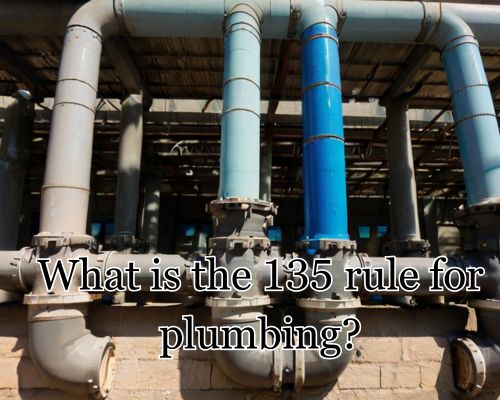Plumbing isn’t just pipes and plungers—it’s a finely tuned science. And when it comes to proper pipe installation, angles matter a lot more than you might think. If you’ve ever had a plumber mention the 135 rule, you’re probably wondering what it means and why it matters to your home in Warragul, Victoria.

In this guide, we break down the 135 rule for plumbing, explain its practical importance, and discuss how it affects both residential plumbing systems and local building codes in the Gippsland region. Whether you’re planning a bathroom renovation or troubleshooting slow drains, this principle could make all the difference.
What Exactly Is the 135 Rule in Plumbing?
The 135 rule in plumbing refers to the angle used when changing the direction of piping—typically for waste water or vent systems. Instead of using a 90-degree elbow, which can cause clogs and poor flow, plumbers often use two 45-degree fittings to create a smoother, more efficient 135-degree turn.
In practical terms:
- A 135-degree fitting configuration offers less resistance.
- It promotes better water flow and reduces the chance of blockages.
- It complies with modern plumbing standards in Australia, especially for long horizontal runs or key connection points.
This rule is especially vital in drain-waste-vent (DWV) systems, where gravity and air pressure must work harmoniously to move wastewater out and fresh air in.
Why Does the 135 Rule Matter in Australian Plumbing?
1. It Aligns With Plumbing Codes
In Australia, plumbing systems are regulated by the National Construction Code (NCC) and AS/NZS 3500 standards. These codes emphasise best practices that promote long-term system health and compliance. Using a 135-degree angle helps meet:
- Minimum flow requirements
- Ventilation standards
- Access provisions for future maintenance
2. It Prevents Costly Drainage Issues
Sharp 90-degree angles can slow down waste flow, leading to:
- Backups in toilets, showers, and sinks
- Frequent blockages, especially in homes with older pipework
- Increased need for professional cleaning and maintenance
Warragul homeowners, particularly in established suburbs like Brandy Creek Road or Bowen Street, often deal with mixed-age housing. The 135 rule can modernise older setups without a full pipe overhaul.
Local Insight: Plumbing in Warragul, VIC
The climate and soil conditions in Warragul, located in the Shire of Baw Baw, create unique challenges for plumbing installations. With high rainfall, seasonal temperature shifts, and a mix of modern and heritage homes, local plumbers must balance drainage efficiency with regulatory compliance.
Here’s why using 135-degree angles is beneficial in Warragul:
- Heavy Rainfall: Efficient stormwater and greywater drainage is critical.
- Tree Roots: In leafy neighbourhoods like Copelands Road and Sutton Street, reducing pressure at joints helps prevent root intrusion.
- Older Plumbing Systems: Retrofitting with modern standards (like the 135 rule) improves longevity and reduces the need for trenching.
If you’re searching for a plumber in Warragul or a licensed tradesperson in West Gippsland, asking about their use of the 135 rule is a great way to gauge their expertise.
135 Rule vs. 90-Degree Fittings: What’s the Real Difference?
| Feature | 90-Degree Elbow | 135-Degree Configuration |
|---|---|---|
| Flow Resistance | High | Low |
| Clog Risk | Higher | Lower |
| Ease of Maintenance | Poor | Improved |
| Compliance | Situational | Often Preferred |
| Air Ventilation Support | Minimal | Optimized |
From this comparison, it’s clear that the 135 rule isn’t just a “nice-to-have.” It’s a best-practice approach that seasoned plumbers in Victoria prefer when designing sustainable plumbing layouts.
Related Plumbing Concepts (LSI Keywords)
To fully grasp the value of the 135 rule, it helps to be familiar with some closely related terms:
- Drainage slope requirements
- Pipe fitting standards
- Vent stack regulations
- Greywater management
- S-traps vs. P-traps
- Backflow prevention
- Wye fittings and long sweep bends
All these elements come together to create a system that’s code-compliant, efficient, and low-maintenance.
Real-World Example: Bathroom Renovation in Warragul
Let’s say you’re renovating a bathroom in a post-war brick home near Burke Street. Your licensed plumber inspects the existing system and notices several 90-degree elbows connecting the toilet waste line.
Instead of replacing the entire drainpipe (which might require jackhammering through concrete), they propose:
- Cutting out the 90-degree section
- Replacing it with two 45-degree elbows
- Realigning the vent to meet the 135-degree flow standard
The result? Improved flushing efficiency, fewer blockages, and increased compliance with AS/NZS 3500.
DIYers: Should You Use the 135 Rule?
If you’re a DIY enthusiast tackling minor plumbing work in Warragul or Drouin, it’s crucial to understand that:
- Not all bends are created equal
- A “quick fix” with a 90-degree bend could cost more down the line
- Compliance with Victorian Building Authority (VBA) requirements is essential
Before grabbing a wrench, consult with a local plumbers or check the Baw Baw Shire Council’s plumbing guidelines. DIY work that doesn’t comply with the code may result in fines or failed inspections.
How to Find a 135-Savvy Plumber in Warragul
Here’s what to ask when hiring a plumbing contractor:
- “Do you use 135-degree fittings in waste systems?”
- “Are you familiar with AS/NZS 3500 standards?”
- “How do you reduce clog risks in older homes?”
- “Can you inspect and retrofit existing 90-degree bends?”
Look for professionals affiliated with:
- Master Plumbers Australia
- Victorian Building Authority (VBA)
- Energy Safe Victoria (for gas plumbing compliance)
Pro tip: Read reviews for Warragul-based plumbing companies and look for mentions of “long-term reliability,” “modern standards,” or “smart drainage solutions.”
Final Thoughts: Small Angles, Big Impact
The 135 rule in plumbing might seem like a minor detail, but in a place like Warragul, where both weather and architecture can be unpredictable, that extra 45 degrees can make all the difference. It’s about more than just flow—it’s about future-proofing your home.
So next time you hear “135,” don’t shrug it off—it’s the quiet hero of high-performance plumbing.